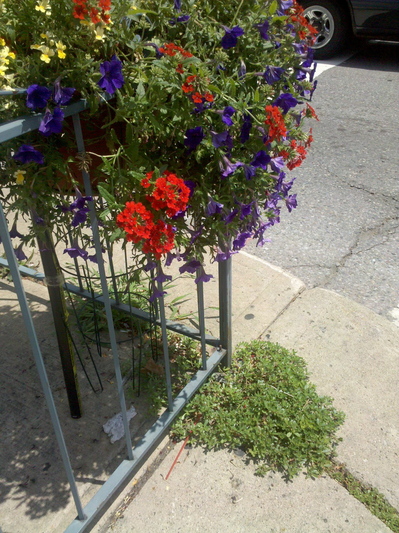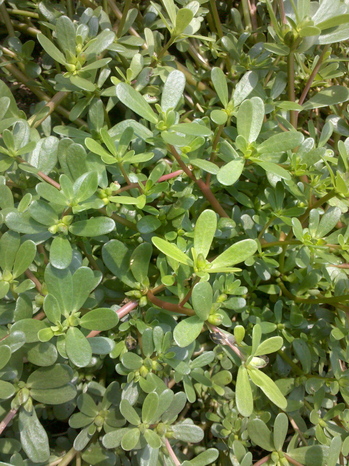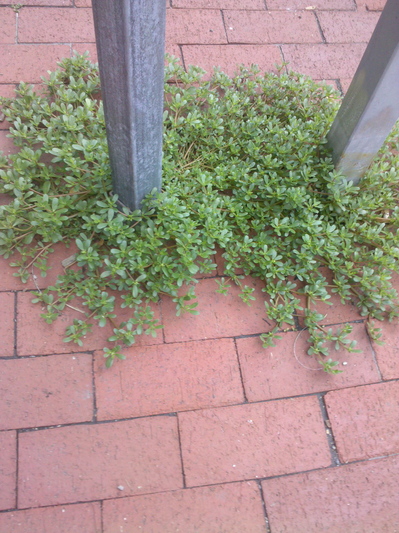Wildcrafting: Purslane is easy to grow and easy to find, with great benefits

At the NW corner of Liberty and Main streets, purslane grows through a crack while the hanging basket attracts the eye.
Linda Diane Feldt | Contributor
The health benefits of a diet high in omega-3s include decrease in inflammation, heart disease and diabetes as well as protection from some cancers.
This lowly weed (it does grow low to the ground) has been tossed aside by many, but it deserves a place of honor in your garden. It looks pretty, it tastes good, it is a nutritional hero, and it is very easy to grow. Or should I say let grow - once begun it will grow itself.
More than 20 years ago I completed a two-year apprenticeship with Susun S. Weed. She has written many books on herbalism, and has a popular website loaded with information. She has this to say about purslane: “Purslane is a superior source of calcium, magnesium, potassium, phenylalanine, and tryptophan, all of which are known to moderate the effects of depressive brain chemicals.”
And there is more!
“Purslane is loaded with nutrients. A single one-cup serving contains all the vitamin E you need in a day, as well as significant amounts of vitamin C and pro-vitamin A. Purslane is one of the very best sources of magnesium. One cup supplies your minimum daily need of 450 mg. Lack of magnesium is associated with diabetes, migraines, osteoporosis, hypertension, and asthma. And, that one cup of fresh purslane gives you over 2000 mg of calcium and 8000 mg of potassium.”
Where can you find it? These photos were all taken in downtown Ann Arbor. It is an annual that replenishes itself by producing thousands of seeds. Transplant a bit from a friend or neighbor (or from a downtown parking meter - last I heard weeds growing by meters were not protected…). Let it go to seed. Reap your rewards in the years to follow.
But if you want to eat it, choose it from a place with less traffic, and that you know hasn't been sprayed or otherwise contaminated.

Purslane is a succulent herb. Juicy with a pleasant mild taste and full of great nutrients.
Linda Diane Feldt | Contributor
How do you eat it? It is a succulent herb, flesh, juicy, moist and tender. It is great raw, especially the new leaves. Take an inch or two from the tip of each branch. Some prefer to trim away the stalk, I don’t mind it at all. You can nibble as you garden. You can add this in large amounts to your green salad. I’m partial to adding it to potato salad. How about gazpacho made with purslane? It might turn it a bit slimy, but only in a good way. Purslane is pretty in a cucumber salad with a bit of olive oil and vinegar. It is especially nice in a quinoa salad. I make mine as a cold salad, with lots of brightly colored veggies (grated carrots and golden beets, red and yellow peppers, slivers of red cabbage, parsley, etc.) with a dressing of ume plum vinegar and olive oil. Purslane is great in a green drink or smoothie, or mixed in with yogurt and garlic for a version of tzatziki sauce.
You can cook purslane as well. I like it lightly stir fried quickly over high heat so it is slightly browned. The leaves can be baked in a casserole, and of course hidden away for extra nutrition in casseroles, loafs, soups and more.
I’ve heard reports of people who make it into jams and jellies, but have yet to taste the result. If you have chickens, there is some evidence that feeding it to them will increase the nutritional benefit - the omega-3 content - of their eggs.

Purslane growing on East William Street in a space in the sidewalk by the library. A great place to see it growing, but I wouldn't pick it and eat it from this well-traveled (by dogs and people) bit of land.
Linda Diane Feldt | Contributor
Purslane is versatile, playful and mild enough to be easily assimilated into your diet all summer long.
We freely spend on flaxseed oil, fish oil, and other sources of omega-3s. Here is a free source, with other benefits as well. It doesn’t preserve well, so enjoy it now, and the health benefits that it will bring you.
While purslane lacks the commercial value - and therefore the marketing success - of flaxseed, it deserves greater recognition and a place at the table. I hope you can find some in your garden, or in the wild, this week.
Linda Diane Feldt is a local Holistic Health Practitioner, writer, and teacher. Her next free class on teaching foraging to children is Thursday, during art fair, at Crazy Wisdom Bookstore form 7-8:30. The class is sponsored by The People’s Food Co-op. You can follow Linda Diane on Twitter, visit her web site, or contact her at ldfeldt(at)holisticwisdom.org


Comments
Milton Shift
Wed, Jul 21, 2010 : 8:13 p.m.
Linda - interesting... do you have any sources I could investigate? It grows wild out by my garden site and I've wanted to toss it into the salad bowl for a while now, but have been leery because of the oxalate issue. Never had a kidney stone, but saw someone get one - looked like it hurt a lot!
amsims
Tue, Jul 20, 2010 : 7:46 a.m.
I have seen purslane seeds in seed catalogs, like Johnny's Selected Seeds or Pinetree Garden Seeds. I am growing some now but haven't done more than nibble on it yet, so the recipes will be helpful!
David Rhoads
Tue, Jul 20, 2010 : 7:33 a.m.
Doug and Karin of Galbraith Farms sell purslane at the Saturday Saline Farmer's Market on S Ann Arbor St from 8 - noon. You can be assured that no contaminants, animal or human, are on their purslane. Also, Doug and Karin are really nice people to know.
Linda Diane Feldt
Mon, Jul 19, 2010 : 8:55 p.m.
I'm not an authority on the oxalic acid question, but it appears to be a bit more complex than it would seem. It behaves differently when in the presence of dietary calcium, combining in the gut and passing normally. When the oxalic acid is not combined with calcium it passes through the intestinal wall to the kidneys and seems to be a concern with the formation of kidney stones. So my understanding is that a plant with high calcium that also contains oxalic acid will protect you from the negative effects. But we're still learning. And there are other gastrointestinal problems that could interfere with the absorption of calcium - would that increase the risk? I don't know. It would make sense for people with calcium deficiencies or inability to absorb calcium to watch oxalic acid intake - as well as limit vitamin C intake which can also form oxalic acid I believe. Also those with existing kidney deficiencies, but I would think they know what special restrictions apply. So I appreciate your comment, and the chance to discuss the issue. If someone has a better explanation of the calcium protection process I would welcome it. Most of the beneficial dark green leafy vegetables also have oxalic acid. And they are all high in calcium. And calcium is such an essential nutrient it is present in nearly all green vegetables. I still recommend them, the value being far greater than the risk except for certain specific exceptions.
Milton Shift
Mon, Jul 19, 2010 : 5:49 p.m.
Purslane also is high in oxalate content, which increases your risk of kidney stones.
Deborah
Mon, Jul 19, 2010 : 12:30 p.m.
I would not have thought this lowly succulent weed would rival flax seed, which has become a yuppie food staple it seems. With your detailed, helpful post, suggestions, and Ed's recipes, seems we've got no excuse not to try this. The vitamins, nutrition & availability are a winner! Also, I just discovered this new application/resource that may be of interest: Real Time Farms is a User-Supported, Local Farmers Market Guide | Lifehacker & Ann Arbor (I blogged about it on Deb Nystrom Lifestream) Ever thought of hanging out in Kerrytown on Farmer's Market days - maybe a strategic partnership with one of the farmers?